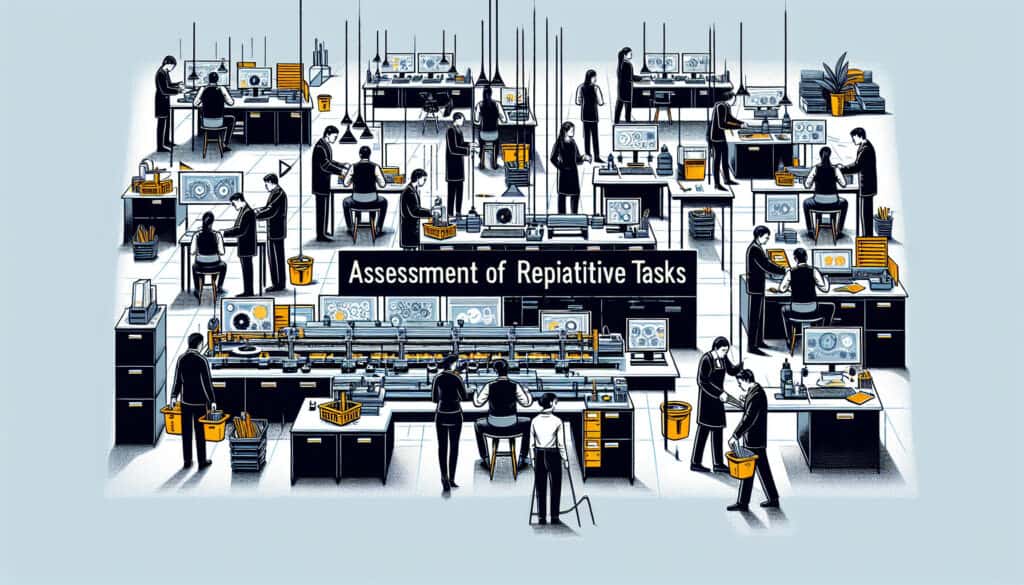A tool developed by the UK’s Health and Safety Executive (HSE) to help assess the risks from repetitive tasks.
- المنهجيات: الهندسة, تصميم المنتج, إدارة المشاريع
Assessment of Repetitive Tasks (ART)

Assessment of Repetitive Tasks (ART)
- التحسين المستمر, بيئة العمل, العوامل البشرية, Human Factors Engineering (HFE), تحسين العمليات, إدارة الجودة, تحليل المخاطر, إدارة المخاطر, السلامة
الهدف:
كيفية استخدامه:
- The ART tool is a simple checklist that helps users to assess the risk factors associated with repetitive tasks, such as repetition, force, and posture. It provides a numerical score that can be used to prioritize high-risk tasks.
الإيجابيات
- Is a simple and easy-to-use tool, can be used by people with limited ergonomic expertise, and provides a clear and simple way to assess the risks from repetitive tasks.
السلبيات
- Is a screening tool and may not be sufficient for a detailed ergonomic assessment, the scoring system is subjective, and it may not be applicable to all types of repetitive tasks.
الفئات:
- بيئة العمل, Human Resources, إدارة المخاطر
الأفضل لـ
- Assessing the risks of upper limb disorders in repetitive tasks.
The Assessment of Repetitive Tasks (ART) methodology is widely applicable across industries such as manufacturing, logistics, healthcare, and assembly lines, where repetitive motions are prevalent. This tool is particularly useful during the design phase of new products or systems, where understanding the ergonomic impact on workers can guide modifications before full-scale implementation. ART assists in identifying tasks that carry a higher risk of upper limb disorders, allowing teams to prioritize interventions that reduce these risks. Participants in this evaluation typically include ergonomists, occupational health experts, and production managers who can utilize the ART checklist effectively even with basic ergonomic knowledge. The numerical scoring provided by ART not only ranks tasks by risk but also facilitates communication regarding safety concerns among project stakeholders. Case studies in automotive assembly lines have demonstrated significant reductions in work-related injuries following ART assessments, illustrating its practical application in real-world scenarios. The simplicity of ART makes it an accessible tool for organizations looking to improve workplace ergonomics without requiring advanced training, making it a valuable resource for small to large-scale operations aiming to enhance worker safety and productivity.
الخطوات الرئيسية لهذه المنهجية
- Identify and list the repetitive tasks being performed.
- Evaluate the frequency of each task occurrence within a set time period.
- Assess the level of force applied during the tasks using standard measures.
- Analyze the posture adopted during task performance, noting any awkward positions.
- Assign a numerical score based on the evaluation criteria for repetition, force, and posture.
- Calculate the total score for each task to determine risk levels.
- Prioritize tasks based on their total risk scores for further action or intervention.
نصائح للمحترفين
- Integrate feedback loops in your ART assessments by collecting input from those directly engaged in the repetitive tasks; this can reveal overlooked risk factors and improve accuracy.
- Utilize the ART scoring system to guide continuous improvement processes, ensuring that high-risk tasks are prioritized for intervention and monitored over time to evaluate the effectiveness of implemented changes.
- Combine the ART assessment with observational methods and additional ergonomic tools, creating a comprehensive approach that addresses both qualitative and quantitative risk factors to enhance intervention strategies.
لقراءة عدة منهجيات ومقارنتها, نوصي باستخدام
> مستودع المنهجيات الشامل <
مع أكثر من 400 منهجية أخرى.
نرحب بتعليقاتكم على هذه المنهجية أو المعلومات الإضافية على قسم التعليقات أدناه ↓، وكذلك أي أفكار أو روابط متعلقة بالهندسة.
منشورات ذات صلة
إدارة عمليات التصنيع (MOM)
نظام تنفيذ التصنيع (MES)
خطة مراقبة التصنيع
الاختبار اليدوي
مخططات تقييم المناولة اليدوية (MAC)
أداة تقييم مخاطر المهام اليدوية (ManTRA)